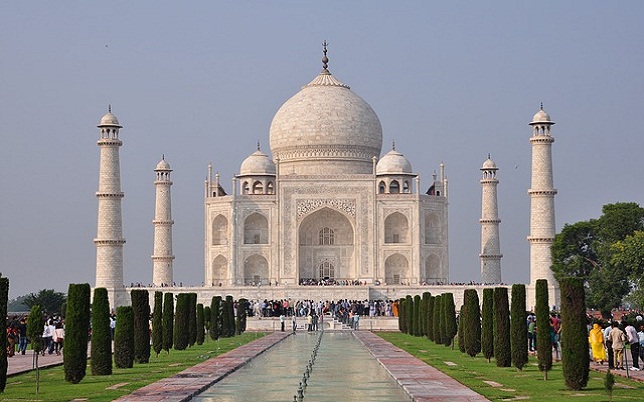Muslims began erecting domed tombs and monuments over their graves, after the initial period of the rightly guided Caliphs and the Prophet’s companions was over, when they increasingly began to adopt the Iranian and Byzantine usages and customs. In the early period of Islamic era, and even in the pre-Islamic days, the Arabs did not erect cupola or roofs supported by pillars over the graves.
How Construction of Tombs Started?
The people of Yemen, belonging to Taba tribe of the Himyrates, however, buried their kings in a standing position and deposited the arms and other articles of personal use of the deceased kings in their masonry graves so that nobody else should use them.
The Yemenites kept the corpse standing in the graves similar to as done by some Christians, perhaps as a good omen, as mentioned by Ibn Hisham in al-Taijan, so that standing dead body should remain alive in the grave.
Construction of Tombs and Shrines in Islam
Islam forbade every usage which smacked of pride or ostentation as a Hadith of Prophet Muhammad says:
“He ordered Ali not to leave a single lofty tomb without levelling it to the ground.”
Another saying of the Prophet related by companion Jabir says that the Prophet Muhammad prohibited erection of pucca graves.
Another companion of Prophet, Abu Saeed Khudri relates that the Prophet forbade construction of any building over the grave.
All these instructions were meant to put an end to idolatry and worship of the graves of pious persons.
But in due course of time Muslims adopted numerous innovations, one of which was to erect lofty tombs and shrines on which they began to waste their wealth merely to display their power and money.
The cemetery in Medina, Baqi-ul-Gharqad, or, al-Muallah in Mecca, had no structure erected over the graves. But later on it became a common feature of the Muslim graveyards.
Contents
Tomb of Saiyid Salar Masud Ghazi
The tomb of Saiyid Salar Masud Ghazi is one of the magnificent shrines in India. The tomb was built, according to Firishta, of burnt bricks and mortar by Muhammad Tughluq.
Ibn Batutah has also made a mention of the shrine which has now become an object of worship by the ignorant folk who make presentations and prostrate before the grave.
Tomb of Sheikh Bahauddin Zakarya of Multan
It is one of the significant monuments of Muslim rulers of Multan. The building has been extensively renovated and additions made to it from time to time but its present form is substantially that of the original. The shrine also contains the tomb of the saint’s son, Sheikh Sadruddin.
Tomb of Khwaja Moinuddin Chishti
It was built at Ajmer in white sandstone by Sheikh Husain bin Khalid Nagauri. This was the first building over the grave of Khwaja Moinuddin Chishti. Thereafter Mahmud Shah Khilji I, the king of Malwa and Akbar added several edifices around the shrine. Shahjahan also erected a mosque of white marble in 1627.
A large number of people make pilgrimage to the saint’s shrine, with the same fervour as they go for Hajj, perambulate or prostrate before it, although all these acts are no better than paganism or ascribing associates to God.
Tomb of Khwaja Qutbuddin Bakhtiyar Kaki
The tomb is in old Delhi. It has a fine marble screen running round the grave which was installed by Farruk Siyar.1 Of the several mosques built near the tomb, one was constructed by Shah Alam.
Tomb of Sheikh Fariduddin Ganj Shakar
This tomb is at Ajodhan.2 One of the doors of the shrine is known as Bihishti Darwaza or the Door of Paradise. Some credulous persons believe that anyone who enters this door shall gain entry to Paradise.
Tomb of Khwaja Nizamuddin Aulia
The mausoleum of Khwaja Nizamuddin Muhammad bin Ahmad Budauni is at Ghiyathpur (now Nizamuddin) at a short distance from old Delhi. The first building of the shrine was constructed under the orders of Muhammad Tughluq. A mosque constructed of white marble is stated to have been erected by Alauddin Khilji. There are a number of other graves, some of which are of certain kings and princes of Delhi, within the enclosure of the shrine.
Tomb of Sheikh Bu Ali Qalandar
Situated at Panipat, this tomb is made up of marble and covered by a magnificent cupola, is surrounded by granite walls. Nearby is a mosque of reddish stone ornamented by elegant carving. The mausoleum is believed to have been erected by one of the sons of Alauddin Khilji, to which further structures were added from time to time by Nawab Muqurrab Khan, Lutf Ullah Khan, Rizq Ullah Khan and others.
Tomb of Ghiyathuddin Tughluq
The mausoleum was built by Muhammad Tughluq at Tughluqabad (Darulaman). The tomb is built of red sandstone and has a simple white marble dome, yet because of Its gorgeous splendour it is regarded as one of the treasured gems of Islamic architecture.
Tomb of Sheikh Ruknuddin
It stands on an elevated mound in Multan. The shrine built by Muhammad Shah Tughluq is a structure of burnt brick, lime and mortar decorated with flowers raised in white and azure colours. The tomb occupies a unique place among the architectural monuments of the city.
Tomb of Sheikh Nasiruddin Mahmud
This mortuary building at Delhi was built by Firuz Shah Tughluq. The masonry building is crowned by a large dome while the inner portion of it is graced by fine lattice-work. Muhammad Shah also made certain additions in the original mausoleum.3
Tomb of Sheikh Burhanuddin Gharib
It is at Aurangabad, 16 km. from the city. Also known as Rauza, the mausoleum has the graves of several kings and nobles.
Tomb of Khwaja Gesu Daraz
The shrine of Sheikh Syed Muhammad bin Yusuf al-Husaini popularly known as Khwaja Gesu Daraz, at Gulbarga is modelled after that of Khwaja Moinuddln Chishti, not only in design but also in delicacy of treatment and artistic refinement.
Tomb of Sheikh Badruddin Madar
This tomb is at Makanpur. The majestic edifice is crowned by a swelling dome. A mosque was built by Aurangzeb near the shrine which is visited by devotees annually like the shrine of Syed SaIar Masud Ghazi.
Tomb of Ahmad Shah Vali
The tomb of Ahmad Shah Vali (d- 1436), the Bahmani King of Deccan, stands on the outskirts of Bidar. The dome of this magnificent building rises to a height of 45 cubits. The interior is adorned with brilliantly coloured paintings in the Persian style and enriched with beautiful inscriptions worked out in golden letters on a deep blue ground.
The edifice is one of the finest specimen of architectural memorials. The tomb of Alauddin Shah, son of Ahmad Shah Vali and other Bahmani kings are also at Bidar.
Tomb of Ali Barid Shah
This tomb at Bidar is an imposing building; the central chamber rises to a height of 64 feet (25.507 meters) with a massive dome of 11 feet (3.048 meters) over it on a mound 75 feet (22.86 meters) high from the ground.
The facade of the building thus towering to about 150 feet (51.42 meters) presents an impressive view while its inner decoration consists of Naskh and Nastaliq inscriptions in gold and deep blue letterings with golden azure painting, it is one of the finest memorials erected in Deccan.
Tomb of Humayun
The tomb was built by Humayun’s widow, Haji Begum in 1567. Completed in 16 years at a cost of rupees 15 lakhs, this magnificent edifice of chiselled stone and marble is surrounded by spacious lawns, gardens, canals and fountains. The mausoleum is perhaps the most attractive Moghul monument excepting, of course, the Taj at Agra.
Tomb of Akbar
This edifice was built at Sikandara near Agra, by his son Jahangir. It is a wonderful pyramidal structure profusely decorated with white marble and ornamented calligraphy.
Jangangir’s Tomb
Built by Shahjahan in 1627 at Shahadra, 6 Km. from Lahore, is a monument of surpassing beauty. This structure of chiselled marble and red stone has been raised on a rocky eminence.
The tomb of the Emperor has been built on a small platform inside the majestic edifice decorated with inlaid semi-precious stones like lapis lazuli, sapphire, coral, jade, etc.
Tomb of Itimad-ud-daula
Standing on the bank of the river Yamuna on a raised ground, the tomb is a fine structural gem of white marble. Its perforated white marble screen and tomb of pale yellow marble present a pleasing contrast. Its delicacy of treatment and chaste quality places It in a class by itself.
Taj Mahal
The majestic mausoleum of Arjumand Banu, built by her husband Shahjahan, standing by the side of the river Yamuna, is a queen of architecture and the most perfect and finest of buildings standing on earth.
The structure was completed by 20,000 workmen labouring for 22 years at a cost of Rs. 3,17,48,026.
All architectural buildings built during the Moghul rule take second place when compared with this masterpiece of Moghul Architecture, the Taj Mahal.
The documents containing a detailed account of those employed on the building, show that the superintendent of the entire project was Ustad Isa, “the best designer of his time”,
Expert craftsmen from Delhi, Lahore, Multan and Qannauj, within the country, as well as from abroad, such as, Baghdad, Shiraz and Bukhara were engaged to execute every specialized phase of work.
The mausoleum of chaste white marble stands on a raised platform occupying a square of 186 feet, with the angles deeply truncated so as to form an unequal octagon.
The great dome having a circumference of 58 feet and its accompanying kiosks rise to a height of 213 feet. At the corners of the rectangular ground storey rise tall and slender minarets of 162.5 feet, in graceful proportion of the central pile.
The internal decorations consist of inlaid work in precious stones such as agate and jasper, with which every spandrel and other salient points in the architecture are richly fretted.
Likewise the inscriptions from the Holy Quran around the main archways, artistically designed and chiseled, and the bold scroll work of flowery pattern add an entrancing charm to its beauty.
Tomb of Muhammad bin Ibrahim Shah
Muhammad Adil Shah, King of Bijapur, himself built this eternal resting place for himself. Its great dome is one of the most striking piece of architecture in India; for the room in which the tomb is located is the largest single cell ever constructed. The entire structure measures 400 feet in length and 150 ft. in width, of which the central portion of the cupola covers eighteen thousand square feet.
Tomb of Rabia-Daurani
Located at Aurangabad, the tomb houses the grave of a queen of Aurangzeb who modelled this monument on the pattern of Taj Mahal. With a surrounding garden leading up to the main building, the monument of pure marble stands on an elevated eminence with four minarets at the corners of the terrace. An amount of Rs. 99 lakhs is reported to have been spent on the construction of the mausoleum which is the most embellished building in Deccan.
Tomb of Safdar Jang
Abul Mansur Khan Safdar Jang was the Prime Minister of Ahmad Shah, one of the later Moghuls. His tomb built by his son Shuja-ud-daula, Nawab of Oudh, at a distance of 6 Km. from Delhi, is a large and pretentious structure. Rupees three lakhs were spent on the construction of this monument.
References
1. Athar-us-Sanadid, p.238
2. Ibid, p.189
3. Ibid, p.203

